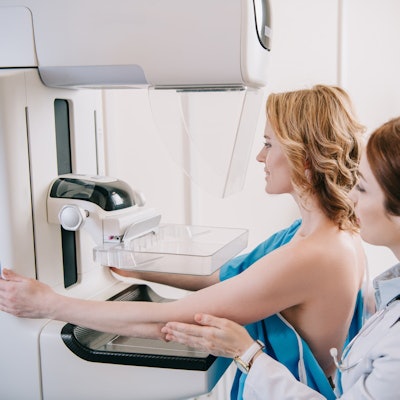
Mandatory paid sick leave is tied to more cancer screening, suggest findings published March 1 in the New England Journal of Medicine.
Researchers led by Kevin Callison, PhD, from Tulane University in New Orleans found that during a seven-year period employer-paid sick leave mandates were associated with a 2.5% to over 4% increase in screening mammography and a nearly 6% to over 8% increase in colorectal cancer screening.
"It is important to make people aware that these benefits exist and that accessing preventive services is an allowable use of their paid sick leave," Callison told AuntMinnie.com.
Under 70% of U.S. adults receive recommended screening for breast and colorectal cancer despite a provision in the Affordable Care Act that eliminated most cost-sharing for cancer screening. Previous reports suggest that work commitments, time constraints, and the possibility of lost wages serve as barriers to screening access. This has led some researchers to point to paid sick leave as a possible way to increase adherence to such preventive services.
However, the U.S. is the only wealthy nation in the world to not federally mandate paid time off for being sick, according to a report by the Center for Economic Policy and Research. Another report by the U.S. Bureau of Labor Statistics suggests that about one in four American workers cannot take a single paid sick day.
Callison and colleagues wanted to analyze changes in breast cancer and colorectal cancer screening rates among nearly two million private sector employees from 2012 to 2019. During this time, "several" states and cities adopted policies ordering paid sick leave. The workers were spread among 300 metropolitan statistical areas, 61 of which were exposed to a paid sick leave mandate during that time frame.
The researchers found in adjusted analyses that cancer screening rates were higher among workers living in areas with mandatory paid sick leave than among workers living in areas without this mandate. This included higher likelihoods by 1.31 percentage points for 12-month colorectal cancer screening, 1.56 percentage points for 24-month colorectal screening, 1.22 percentage points for 12-month mammography, and 2.07 percentage points for 24-month mammography.
This all translates to an additional 142,605 and 249,559 workers completing screening mammography in a given year after mandate adoption over the previous 12 and 24 months, respectively, the team wrote. It also estimated that mandate adoption leads to an additional 242,633 and 298,625 workers who completed colorectal-cancer screening over the previous 12 and 24 months, respectively.
The study authors wrote that their data did not contain information on paid sick leave coverage, leading them to having estimates of the association between such mandates and cancer screening averaged across all workers in their sample. Many of these would have already had paid sick leave coverage in the absence of a mandate, they suggested.
"Therefore, our estimates probably understate the association between paid sick leave mandates and cancer screening among those gaining coverage," they wrote.
The researchers also wrote that their results provide evidence for policymakers looking toward solutions in addressing insufficient screening adherence. They added that the results highlight "an understudied benefit of expanding paid-sick-leave coverage."
Callison told AuntMinnie.com that future work will look at how paid sick leave may reduce disparities in cancer screening by income, race and ethnicity, and insurance status. "We also hope to examine downstream outcomes, including cancer stage at diagnosis and time from diagnosis to treatment," he said.




















